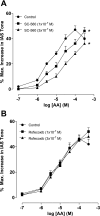Arachidonic acid metabolites follow the preferential course of cyclooxygenase pathway for the basal tone in the internal anal sphincter
- PMID: 19221012
- PMCID: PMC2670678
- DOI: 10.1152/ajpgi.90707.2008
Arachidonic acid metabolites follow the preferential course of cyclooxygenase pathway for the basal tone in the internal anal sphincter
Abstract
Present studies determined the roles of the cyclooxygenase (COX) versus the lipoxygenase (LO) pathways in the metabolic pathway of arachidonic acid (AA) in the internal anal sphincter (IAS) tone. Studies were performed in the rat IAS versus the nontonic rectal smooth muscle (RSM). Indomethacin, the dual COX inhibitor, but not nordihydroguaiaretic acid (NDGA), the LO inhibitor, produced a precipitous decrease in the IAS tone. However, when added in the background of indomethacin, NDGA caused significant reversal of the IAS tone. These inhibitors had no significant effect on the RSM. To follow the significance of COX versus LO pathways, we examined the effects of AA and its metabolites. In the IAS, AA caused an increase in the IAS tone (Emax=38.8+/-3.0% and pEC50=3.4+/-0.1). In the RSM, AA was significantly less efficacious and potent (Emax=11.3+/-3.5% and pEC50=2.2+/-0.3). The AA metabolites (via COXs) PGF2alpha and U-46619 (a stable analog of thromboxane A2) produced increases in the IAS tone and force in the RSM. Conversely, AA metabolites (via 5-LO) lipoxin A4, 5-HETE, and leukotriene C4 decreased the IAS tone. Finally, the contractile effects of AA in the IAS were selectively attenuated by the COX-1 but not the COX-2 inhibitor. Collectively, the specific effects of AA and the COX inhibitor, the Western blot and RT-PCR analyses showing specifically higher levels of COX-1, suggest a preferential role of the COX (specifically COX-1) pathway versus the LO in the regulation of the IAS tone.
Figures








References
-
- Bellicini N, Molloy PJ, Caushaj P, Kozlowski P. Fecal incontinence—a review. Dig Dis Sci 53: 41–46, 2008. - PubMed
-
- Bharucha AE, Fletcher JG. Recent advances in assessing anorectal structure and functions. Gastroenterology 133: 1069–1074, 2007. - PubMed
-
- Biancani P, Walsh JH, Behar J. Vasoactive intestinal polypeptide: a neurotransmitter for relaxation of the rabbit internal anal sphincter. Gastroenterology 89: 867–874, 1985. - PubMed
-
- Cao W, Harnett KM, Behar J, Biancani P. Group I secreted PLA2 in the maintenance of human lower esophageal sphincter tone. Gastroenterology 119: 243–252, 2000. - PubMed
Publication types
MeSH terms
Substances
Grants and funding
LinkOut - more resources
Full Text Sources
Research Materials
Miscellaneous

